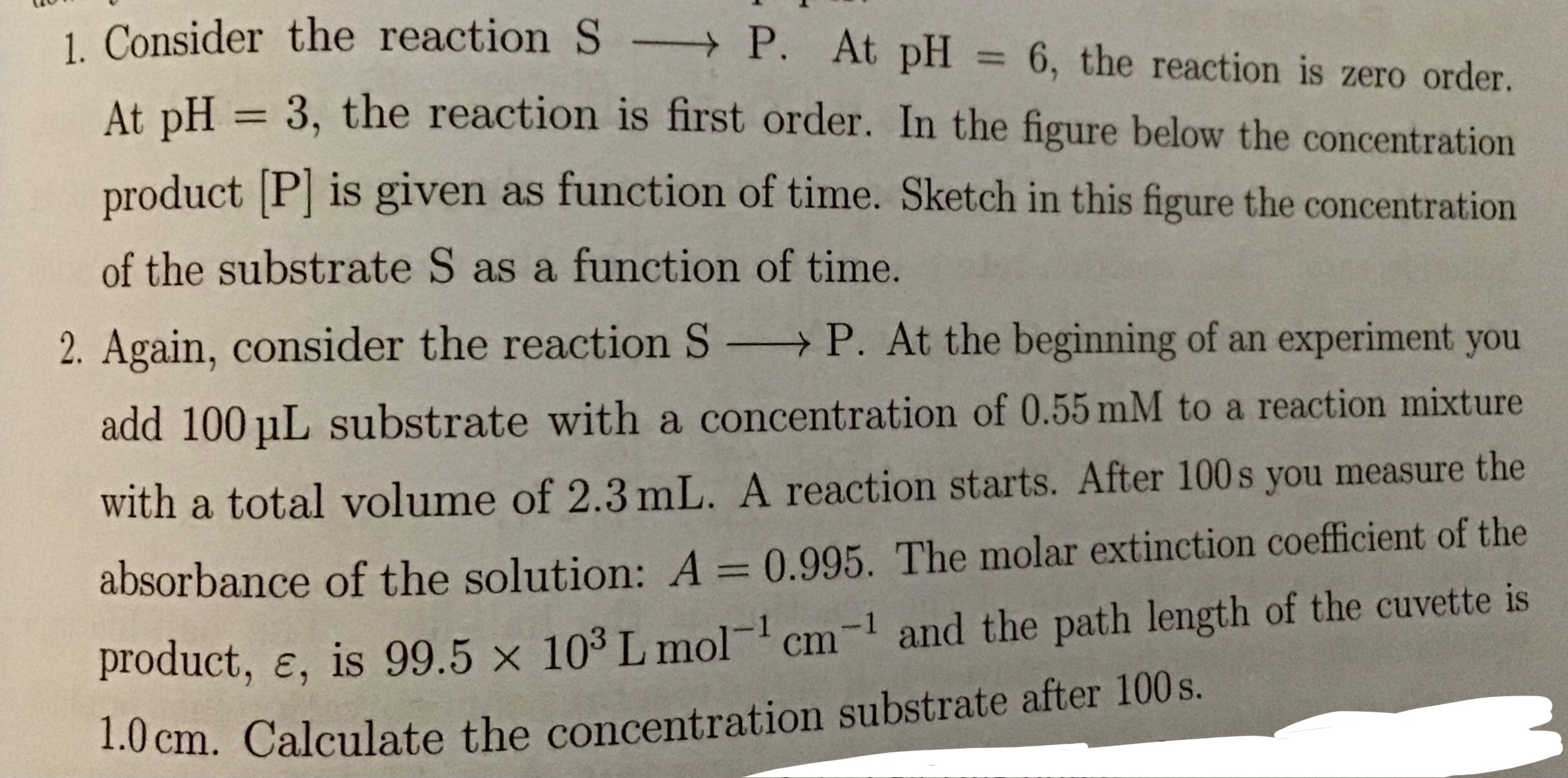1. Consider the reaction S -> P. At pH = 6, the reaction is zero order. At pH = 3, the reaction is first order. In the figure below the concentration product [P] is given as a func... 1. Consider the reaction S -> P. At pH = 6, the reaction is zero order. At pH = 3, the reaction is first order. In the figure below the concentration product [P] is given as a function of time. Sketch in this figure the concentration of the substrate S as a function of time. 2. Again, consider the reaction S -> P. At the beginning of an experiment you add 100 µL substrate with a concentration of 0.55 mM to a reaction mixture with a total volume of 2.3 mL. A reaction starts. After 100 s you measure the absorbance of the solution: A = 0.995. The molar extinction coefficient of the product, ε, is 99.5 x 10^3 L mol^-1 cm^-1 and the path length of the cuvette is 1.0 cm. Calculate the concentration substrate after 100 s.

Understand the Problem
The image presents two related chemistry problems. The first problem asks to sketch the concentration of the substrate S as a function of time, given that the reaction S -> P is zero order at pH 6 and first order at pH 3, and knowing the concentration of product P as a function of time. The second problem requires calculating the concentration of substrate S after 100 seconds, given initial conditions, the absorbance of the solution after 100s, the molar extinction coefficient of the product, and the path length of the cuvette.
Answer
1. Sketch: $[S]$ vs time, linear decrease for pH 6, exponential decrease for pH 3. 2. $[S]_{100} = 1.39 \times 10^{-5} \text{ M}$
Answer for screen readers
- The sketch should show a straight line with a negative slope for pH = 6 and an exponential decay for pH = 3 (see plot in the answer info for an example sketch).
- The concentration of substrate after 100 seconds is $0.0139 \text{ mM}$ or $1.39 \times 10^{-5} \text{ M}$.
Steps to Solve
- Sketching [S] vs. time for zero order reaction
For a zero-order reaction, the rate of disappearance of the substrate is constant, meaning $[S]$ decreases linearly with time. Since $[P]$ increases linearly, $[S]$ must decrease linearly. If we assume an initial concentration of $[S]_0$ at $t=0$, $[S]$ will decrease according to $[S] = [S]_0 - kt$, where $k$ is the rate constant. Thus, plot a straight line with a negative slope such that $[S]$ decreases as $[P]$ increases.
- Sketching [S] vs. time for first order reaction
For a first-order reaction, the rate of disappearance of the substrate is proportional to the substrate concentration. This means $[S]$ decreases exponentially with time. The equation is $[S] = [S]_0 e^{-kt}$. In this case, the rate of production of product P decreases over time, and thus the rate of S consumption also decreases over time. The plot of [S] concentration should represent an exponential decay.
- Calculating the initial concentration of substrate [S]
First, calculate the initial concentration of the substrate after it has been added to the reaction mixture. We can use the dilution formula:
$C_1V_1 = C_2V_2$
where $C_1$ is the initial concentration of the substrate, $V_1$ is the volume of the substrate added, $C_2$ is the final concentration of the substrate in the reaction mixture, and $V_2$ is the total volume of the reaction mixture. Solving for $C_2$:
$C_2 = \frac{C_1V_1}{V_2} = \frac{(0.55 \text{ mM})(100 \text{ µL})}{2.3 \text{ mL}}$
- Convert units
We convert the volumes to the same units. Since 1 mL = 1000 µL:
$C_2 = \frac{(0.55 \text{ mM})(100 \text{ µL})}{2300 \text{ µL}} = 0.0239 \text{ mM}$
- Calculating the concentration of product [P] after 100 seconds using Beer-Lambert Law
We use the Beer-Lambert Law to find the concentration of the product after 100 seconds:
$A = \epsilon \cdot l \cdot [P]$ where $A$ is the absorbance, $\epsilon$ is the molar extinction coefficient, $l$ is the path length, and $[P]$ is the concentration of the product. Solving for $[P]$:
$[P] = \frac{A}{\epsilon \cdot l} = \frac{0.995}{(99.5 \times 10^3 \text{ L mol}^{-1} \text{cm}^{-1})(1.0 \text{ cm})}$
$[P] = 1.0 \times 10^{-5} \text{ M} = 0.01 \text{ mM}$
- Calculating the concentration of substrate [S] after 100 seconds
Since the reaction is $S \rightarrow P$, the amount of substrate that has reacted is equal to the amount of product formed. Therefore, the concentration of substrate remaining after 100 seconds is:
$[S]_{100} = [S]0 - [P]{100} $
$[S]_{100} = 0.0239 \text{ mM} - 0.01 \text{ mM} = 0.0139 \text{ mM}$
- The sketch should show a straight line with a negative slope for pH = 6 and an exponential decay for pH = 3 (see plot in the answer info for an example sketch).
- The concentration of substrate after 100 seconds is $0.0139 \text{ mM}$ or $1.39 \times 10^{-5} \text{ M}$.
More Information
- Here is a description of how the plot should look:
- pH = 6: A straight line starting at an arbitrary concentration [S]$_0$ and decreasing linearly with time. The exact slope is not defined, but it should be a straight line.
- pH = 3: An exponential decay curve starting at an arbitrary concentration [S]$_0$ and decreasing exponentially with time.
- The final concentration of substrate is $1.39 \times 10^{-5} \text{ M}$, meaning that a very small amount remains.
Tips
- Forgetting to convert units (µL to mL)
- Not using the correct formula for dilution
- Incorrectly applying the Beer-Lambert Law
- Confusing initial and final concentrations
- Not understanding the difference between zero-order and first-order reactions.
AI-generated content may contain errors. Please verify critical information